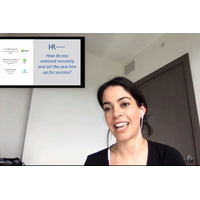
10 Tips for Remote Recruiting and On-boarding
Remote recruiting and on-boarding is hard.
We recently hosted a webinar on the topic and were fortunate to have Tim Khoo-Jones, Senior Talent Acquisition Lead at Shopify, Saleema Chaudhry, Talent Acquisition Manager at PayByPhone and Ilya Brotzky, CEO and co-founder of VanHack join us for a panel discussion.
With such diverse perspectives from an award-winning start-up, a high growth SME and a tech unicorn, I took a lot of notes! Here are 10 tips and ideas from the conversation.
Let’s start with sourcing.
Tip #1. Virtual hiring events are proving effective for sourcing. Consider hosting webinars for candidates so they can learn about your company. Location is no longer a barrier for attending. Attend virtual career fairsbeing organized by post-secondary institutions and industry associations.
Tip #2. Virtualize your job postings. The job has changed. Make sure the posting has too.
What about assessment? We’re accustomed to bringing someone to our office where we can interview them, test them and watch them interact with a number of different people. How do you assess candidates’ skills and capabilities from afar?
Tip #3. Watch out for unconscious bias. It’s magnified in a remote setting.
Unconscious bias training is more important than ever. Do more of it.
Build your hiring team’s awareness about potential bias “traps”. Check your own biases before starting an interview.
Some additional biases that candidates face in a remote interview setting are:
- Technical difficulties during interview = inability to work from home
- Lower than average communication skills = inability to perform the job well
- Messy background, poor lighting, bad camera angle = general incompetence
- Inexperienced = too risky. unlikely to perform job well from home
These are not facts. These are common biases that candidates are facing right now, in a remote setting. Watch for these, on top of other unconscious biases.
Tip #4. Be flexible with candidates. Internet connections lag and drop. Construction happens next door. Babies cry. Poop happens! Know that it will and prepare to adjust for it. Work to put the candidate at ease when it happens.
Tip #5. Try new assessment tools. They won’t always work so you may need to keep trying. Maybe it’s as simple as using shared Google docs. Give candidates “take home projects” to get a sense for their skills.
Compensation and relocation need to be considered in a remote model.
Tip #6. Determine your compensation and relocation approach before you’re in the thick of it with a candidate. Some companies are stipulating compensation levels based on the local home country of the hire. If they are living and working in Costa Rica, their compensation is X. If/when they relocate to Canada, their compensation becomes Y. Determine if it’s even feasible to have someone work for your company from another country. You’ll need to pay them through a legal entity in the country in which they reside. Is it cost effective to have someone in a high cost global location? Much to consider.
Remote on-boarding is hard.
How do you welcome people and connect them to your organization and your company culture?
Tip #7. Education – Figure out what additional context new hires need. Provide more documentation than you did before. Spend more time educating new hires on your tools, processes and expectations. Be very clear on what's expected.
Tip #8. Build connection – Build relationships. Focus on building two-way trust. Have weekly one-on-ones between the new hire and their manager. Get everyone in the company/division/team (depending on your size) to reach out and personally introduce themselves to the new hire. Survey the new hires after 1 week, 1 month, 3 months. Tap your ‘cultural leaders’ to connect individually with new hires and loop them in socially.
Tip #9. Watch your language! Don’t inadvertently create a barrier to belonging.
Pre-COVID hires worked together in an office. They have a security ID badge. They met Dale’s friendly old dog and they know the receptionist well. They remember hanging out Friday nights at the beer fridge. Post-COVID hires do not.
Remove the ‘in-office’ language and lore from stories, conversations and documentation, especially if remote work is here to stay for many months or more.
Employee burnout was identified as a challenge right now. Some good mitigation ideas came forward from panelists and participants, like encouraging accountability partners who can hold each other to task to commit to their stated personal boundaries, like setting core hours for a team, and offering additional wellness and mental health resources. (think of these as bonus tips, leading up to tip #10)
All that said, from interviewing to on-boarding, empathy was the word of the day.
Tip #10. Have empathy.
WANT TO LEARN MORE ABOUT OUR DIVERSITY AND INCLUSION WORK? Check it out here.
